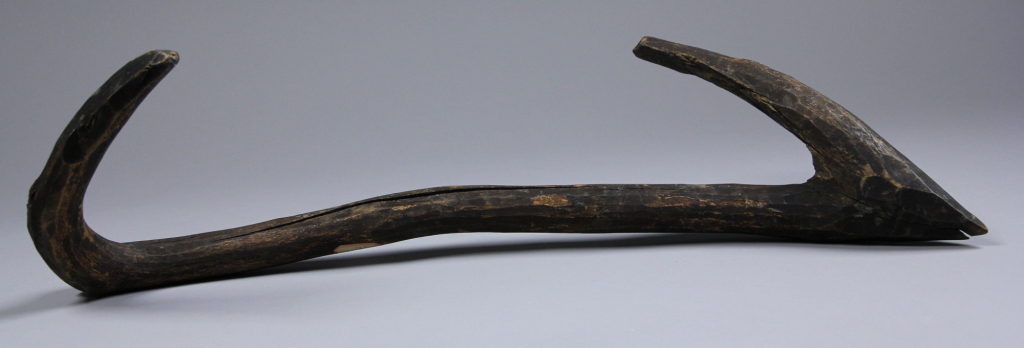
Curated by Alan Corbiere
The text for this exhibit was first published by Alan Corbiere in the Newsletter for the Ojibwe Cultural Foundation (6:4 May 2011). Updates for this online version by Kate Higginson (2017).
Some Anishinaabeg call April Ziisbaakwadoke-giizis ‘sugar making moon’ others call it Namebine-giizis ‘sucker moon,’ but it depends where you are from. Different regions have some different names for the moons of the year. However, all across Anishinaabe-akiing (Indian country), the Anishinaabeg make syrup, sugar, taffy and candy from the sap of the maple tree.
Elder Nmenhs – Arthur McGregor of Whitefish River First Nation
I have heard the sap called ninaatigwaaboo ‘maple tree water’, wiishkabaaboo ‘sweet water’, and ziisbaakwadaaboo ‘sugar water.’ I have heard that the birch tree is tapped sometimes as well, for medicinal purposes as well as flavouring. I imagine the sap from the birch tree is called wiigwaasaatigwaaboo, or if it is the yellow birch, wiin’zikwaaboo.
I presume it was easy enough for the Anishinaabe to figure out that the trees would give water, but how did they know to boil it down to make sugar? The answer is in a story called “Bgoji-nishnaabenhsag – Little people” which was related by Wiigwaaskingaa (Whitefish River) Elder Nmenhs (Arthur McGregor):
Gchi-mewzha go gonda bgojinishnaabenhsag bi ko yaawaad maampii gidkamig. Kina go mziwe yaawag. Naangodnoong gaawiin gdoo-waabmaasiig, yaawag dash wii go. Gaawiin ngikendamaasiig yaawaad. Gaawiin ooya bbaamendmaasiiwaan. Mii ninda Nishnaabeg gaa-kinoomaagwaajin waa-zhi-ziisbaakdokewaad. Ninaatigo-ziiwaagbmide gii- zhichgaade maampii Canada jibwaa-dgoshnawaad gonda waabshkiiyejig gchi-gaaming bi-njibaajig. Mewzha, bgojinishnaabenhsag gii-yaanaawaa niigaan-nendmowin, noongo ezhinikaadeg ‘telepathy.’ Epiichi- nbaaying, Bgojinishnaabenhsag kii-wiindamaagnaanik waa- zhi-zhitooying ninaatigo- ziiwaagbmide. Kii-wjitoonaa, gii-nakiimgad dash go. Noongo
go geyaabi zhichgaade ninaatigo- ziiwaagbimide. Mii gonda bgojininiwag gaa-zhichgewaad, gaa-zhi-kinoomaagyiing. Bgojinishnaabenhsag, yaawag go geyaabi.
Those little beings have been around this earth for a long time, and there are more of them, all over this country. But you can’t see them, sometimes, but they are around though. I don’t know where they are. They never hurt anybody. And that’s how the Native people learned how to make maple syrup. Maple syrup was being made here, in Canada, long before the Europeans came here. A long time before, Bgojinishnaabenhsag had, what most people describe as ‘telepathy.’ While we were sleeping, Bgojinishnaabenhsag told us how to make maple syrup. So, when we were told how to make it, we tried it and it worked. It’s still being made today, but, it was those little wild men that told us how to do it. Bgojinishnaabenhsag, they are around yet.
[Arthur McGregor, “Wiigwaaskingaa: Land of the Birch Trees,” p. 40 – 41].
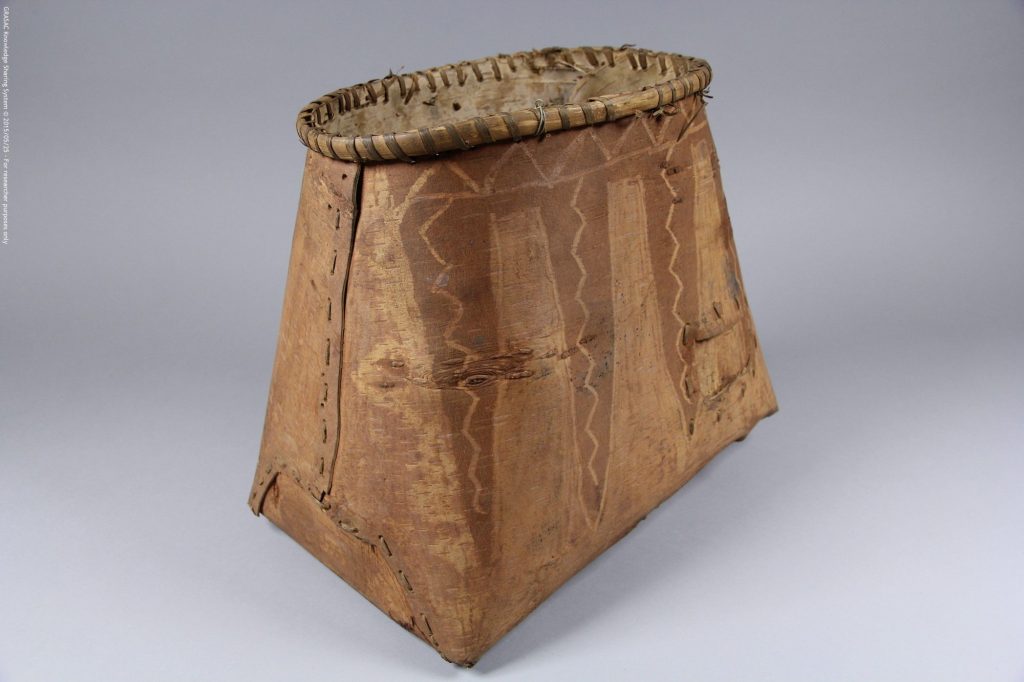
So the little wild people gave us a gift, long, long time ago. They told us how to do it but I still wondered how our ancestors did it without metal.
About 10 years ago I had bought a Canadian Geographic Magazine and the cover had a beautiful Anishinaabe-mindimoowenh (Female elder) on it, she worked at Fort William Historic park and she was pictured making a makak (or as it is written in English: mokuk). These are birch bark containers that were used to store maple sugar, among other things. The magazine article was really a plug for Fort William but it also had a side bar feature that was really interesting. In the sidebar, they scientifically explained how the Anishinaabeg of old boiled down the sap before the Wayaabshkiiwed (Pale-face) arrived, that is, how the Anishinaabe boiled sap to sugar without metal, just bark and heated stones. Unfortunately I could not find the magazine to refer to it, even though I know I kept it (I am a bit of a pack rat for stuff like that). Since that particular tidbit is out of reach, I have to substitute it with a description of the maple sugar making process as witnessed by fur trader Alexander Henry, who was trading up around Sault Ste Marie between 1760 and 1776:
The lands, between the Bay of Boutchitaouy [Batchewana] and the Sault, are generally swampy, excepting so much of them as compose a ridge, or mountain, running east and west, and which is rocky, and covered with the rock or sugar maple, or sugar-wood. The season, for making maple-sugar, was now at hand; and, shortly after my arrival at the Sault, I removed, with the other inhabitants, to the place at which we were to perform the manufacture.
A certain part of the maple-woods having been chosen, and which was distant about three miles from the fort, a house, twenty feet long, and fourteen broad, was begun in the morning, and before night made fit for the comfortable reception of eight persons, and their baggage. It was open at top, had a door at each end, and a fire-place in the middle, running the whole length.
The next day was employed in gathering the bark of white birch- trees, with which to make vessels to catch the wine or sap. The trees were now cut or tapped, and spouts or ducts introduced into the wound. The bark vessels were placed under the ducts; and, as they filled, the liquor was taken out in buckets, and conveyed into reservoirs or vats of moose-skin, each vat containing a hundred gallons. From these, we supplied the boilers, of which we had twelve, of from twelve to twenty gallons each, with fires constantly under them, day and night. While the women collected the sap, boiled it, and completed the sugar, the men were not less busy in cutting wood, making fires, and in hunting and fishing, in part of our supply of food.
The earlier part of the spring is that best adapted to making maple-sugar. The sap runs only in the day; and it will not run, unless there has been a frost the night before. When, in the morning, there is a clear sun, and the night has left ice of the thickness of a dollar, the greatest quantity is produced. On the twenty-fifth of April, our labour ended, and we returned to the fort, carrying with us, as we found by the scales, sixteen hundred weight of sugar. We had, besides, thirty-six gallons of syrup; and, during our stay in the woods, we certainly consumed three hundred weight. Though, as I have said, we hunted and fished, yet sugar was our principal food, during the whole month of April. I have known Indians to live wholly upon the same, and become fat.
[Alexander Henry, “Travels and Adventures in Canada and the Indian territories between the years 1760 and 1776 in two parts” p. 68 -70].
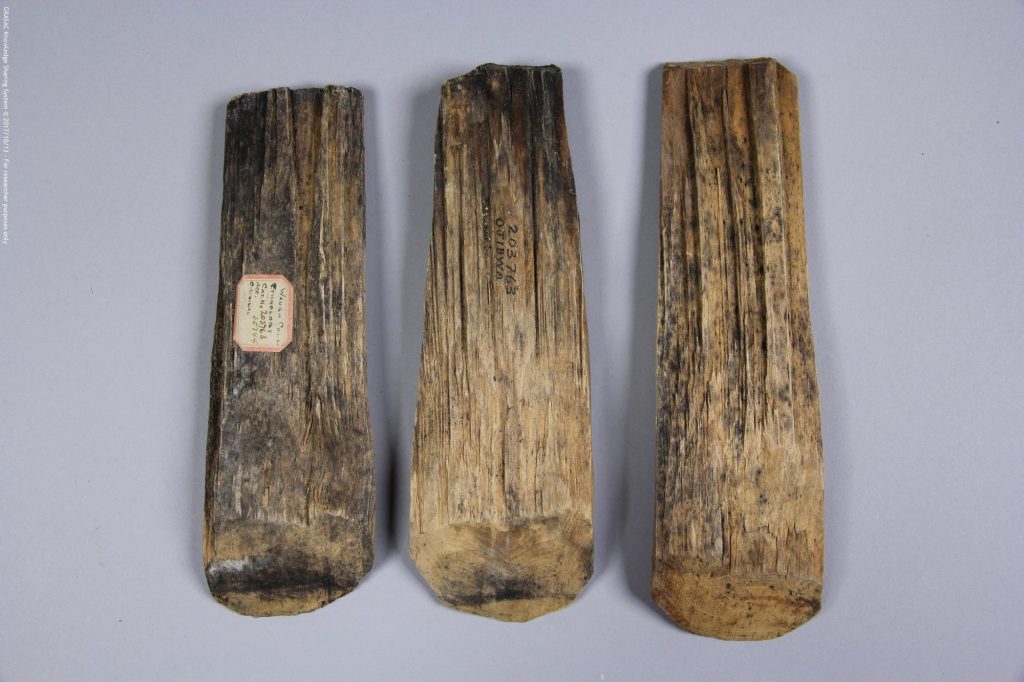
Unfortunately, Henry did not state if they used kaadi-kik’ (metal legged kettles) to boil down the sap. Henry mentioned the biskitenaagan that is made of birchbark to catch the sap under the tree. He did not mention the cedar slats used as the spouts either but these can be inferred (see the images of the wooden spouts above). He did mention though, that the sap was stored in “vats of moose-skin” before boiling. It would be interesting to see a depiction or an example of these moose-skin vats that could hold up to 100 gallons.
Also mentioned is that the “Indians live wholly on the same [maple sugar] and become fat.” Legend has it that at one time, thick, sweet syrup used to flow right out of the maple trees. All the Anishinaabeg had to do was cut the tree, lie under it with their mouth open and get their fill. Soon the Anishinaabeg grew fat and lazy, never straying far from the maple tree. Of course Nenaboozhoo, our great uncle, fixed that! Andrew J. Blackbird, an Odawa from Harbour Springs Michigan, wrote about this in his book History of the Ottawa and Chippewa Indians of Michigan, in 1887:
…Ne-naw-bo-zhoo, was the most remarkable, wonderful, and supernatural being that ever trod upon the earth. He could transfigure himself into the shape of all animals and live with them for a great length of time. He has done much mischief and also many benefits to the inhabitants of the earth whom he called “his nephews” and he shaped almost everything, teaching his nephews what materials they should take for their future utensils. This mischievous Ne-naw-bo-zhoo spoiled the sugar trees by diluting their sap with water. The legends say, that once upon a time the sugar trees did produce sap at certain season of the year which was almost like a pure syrup; but when this mischievous Ne-naw- bo-zhoo had tasted it, he said to himself, “Ah, that is too cheap. It will not do. My nephews will obtain this sugar too easily in the future time and the sugar will be worthless.” And therefore he diluted the sap until he could not taste any sweetness therein. Then he said, “Now my nephews will have to labor hard to make the sugar out of this sap, and the sugar will be much more valuable to them in the future time.”
[Andrew J. Blackbird, 1887, “History of the Ottawa and Chippewa Indians of Michigan” p. 72]
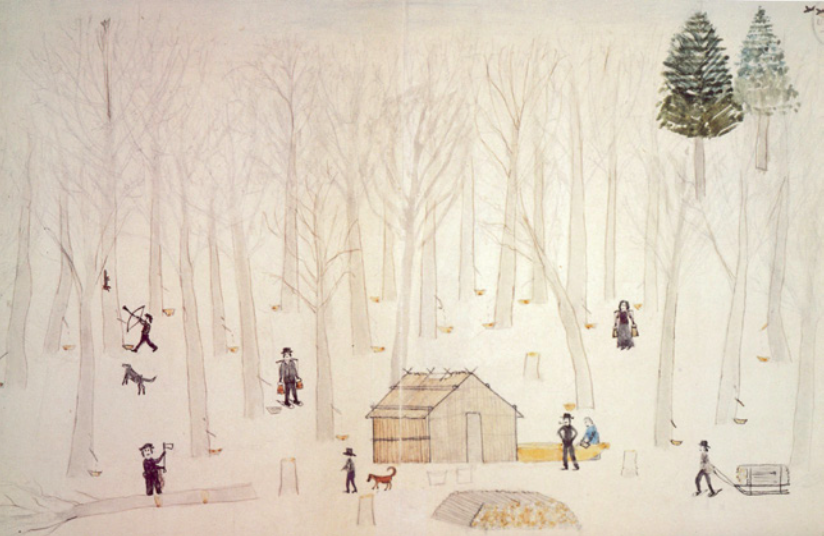
Truly the Anishinaabeg did learn to value the sugar that they made and they would spend weeks on end making it. It was labourous and sometimes the return did not seem worth it, especially to non-Native people, specifically the Jesuits. The Jesuits stationed at Holy Cross mission in Wikwemikong witnessed firsthand the amount of labour that went into sugar making, and they noted that the Anishinaabeg never complained about the amount of work it took for (what the Jesuits thought was) so little in return. Fr. Hanipaux reported from Holy Cross Mission (Wikwemikong) to his superior on April 29, 1846, that:
For the last two months, here, our native people have been busy in the woods making maple sugar. They return laden with an extraordinary amount of it. The village of Saint-Croix alone, which has 80 to 100 families, collected 80,000 pounds of it. This would be very profitable for them if, instead of exchanging it for almost nothing, they could sell it at its fair price. The merchants with whom they deal claim, it is true, to buy the sugar from them at eight or nine cents a pound. But when it comes to paying them, instead of money they give them fabrics to which they attach any price they please, so that in the end the poor native receives only three or four cents for a pound of sugar.
To make this sugar however, had been extremely difficult. He had to spend about two months continually in the snow and close to the fire. At the beginning, our people are in the snow to collect the sap that flows drop by drop from the notches they have made in the trees. Below these openings they place small bark cups they have in large numbers and are always on the run to see if these cups are full and then pour them into large tubs. Once this sap is collected, it must be brought to a boil; practically all of it is dissipated in steam.
A barrel of sap yields perhaps one pound of sugar and this sap must be further reduced to the point that a pound of sugar is all that remains. When it is thus reduced, it has to be beaten to reduce it into solid chunks. They continually feed a large fireplace to make the sap boil and to reduce it into steam. Above it at a height of seven or eight feet are some thick beams similar to those that support the first story of a building. From these beams hang some hooks that are used to hold the boilers containing the sap.
Even though these hooks and the lines that hold the boilers are made of wood and are above the fireplace, they do not burn because the boilers are pressed against one another and prevent the flames from reaching the hooks and lines. But frequently these dry out and break because of the excessive heat, and they must be replaced from time to time. It is certainly not cold around the fireplace, and yet the Natives must spend their six weeks there to stoke the fire, to pour the sap into boilers, and to draw off the residue.
Despite all this hard work, these good people are satisfied when they have made a large amount of sugar. It is the sole object of trade that they have, with the exception of the fish some of them sell to the merchants. They have had to make a great sacrifice when, to live their Catholic religion better, they came to settle in this village where they do not have any hunting. That is one of the reasons therefore why they are very deserving when they beg for pity from the Propagation of the Faith for help to build a church. Our poor little bark-covered wooden chapel is almost ready to collapse.”
[Lonc and Topp, “Letters from the New Canada Missions,” Vol. 6-1, pt. 1: p 391 – 392].
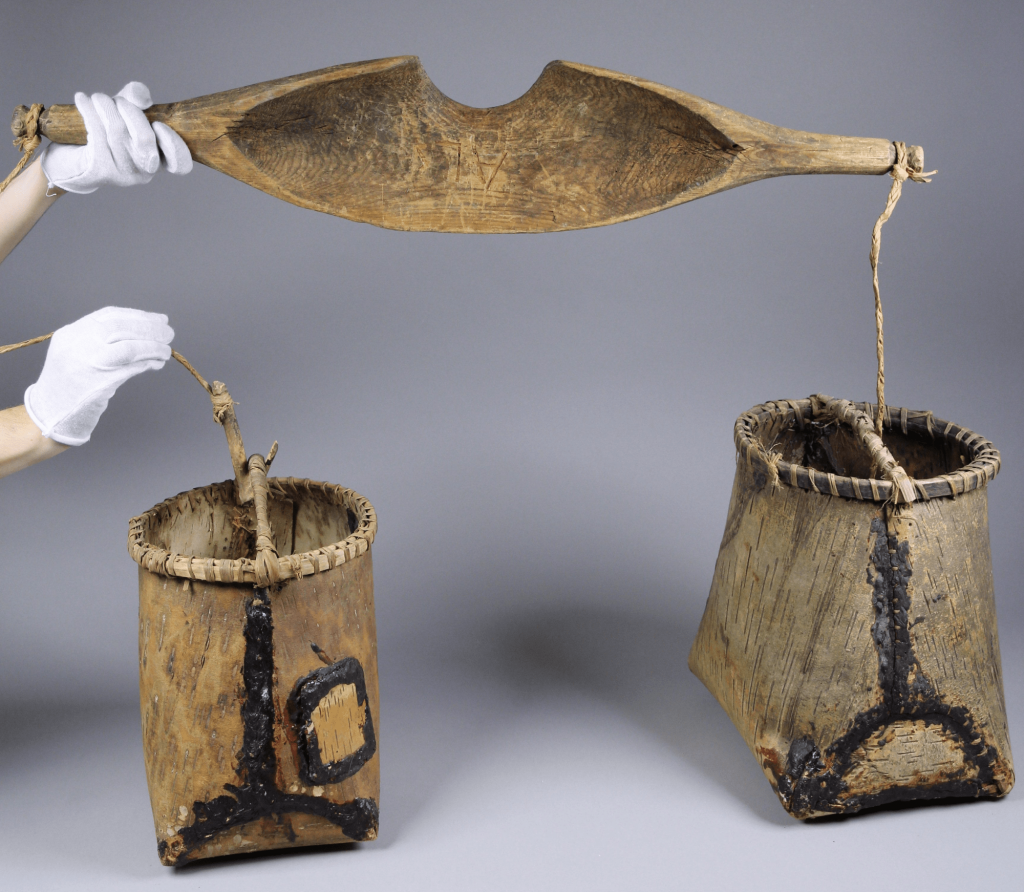
First of all, I cannot fathom 80,000 pounds of sugar!
The Jesuits recognized how much work went into making the sugar and felt that the traders were ripping off the Anishinaabeg by trading for cheap cloth instead of giving them actual money. This was one way that the traders made their profit. Another way was by trading the Anishinaabe sugar for whiskey – usually watered down whiskey too! In later years the missionaries, Anglican and Roman Catholic, would complain about the sugar making season and stated that it took the ‘sheep away from the shepherd’ for too long. Sugar making season, in the eyes of the missionaries became a time when the Native people were beyond their control and were exposed the world’s vices, particularly the vices offered by traders such as ishkotewaaboo ‘firewater’. The missionaries also complained of how much time away was spent from the village and that very few would attend church or confession. In effect, all of the missionaries’ preaching had become undone, in their eyes, because of the traders and their ‘vile goods’. Later, the missionaries started to discourage people from going to the sugar camps and taking their children there due to the perceived lack of morality and instruction.

The Anishinaabeg had faced this type of proscription against selling their sugar before, but from their own people. Prior to the War of 1812, a prophet arrived amongst the Shawnee people who said that he was the incarnation of the ‘first man’ created. This Shawnee, who was the great Tecumseh’s brother, was called Tenskwatawa ‘the open door.’ He preached to, and taught many people about his vision and the instructions he received from the Great Spirit. Some people listened and became his ‘disciples,’ who then went to preach the message to their own nations. An Odawa chief from L’Arbre Croche (Harbour Springs/ Cross Village) named Le Maigous [Namegoos] ‘Trout’ delivered the message to the chiefs and warriors up in the Michilimackinac area. The prophet, much like the above mentioned Jesuits, also preached that the traders were cheating the Anishinaabeg and that the traders gave them whiskey to rob them. The Prophet proclaimed that the Anishinaabe must return to the ways of the forefathers and forego any products or tools of the ‘whiteman’. The following is an excerpt of his teachings in reference to maple sugar as recited by Namegoos:
My Children – I made all the Trees of the forest for your use but the Maple I love best because it yields sugar for your little ones. You must make it only for their use, but sell none of it to the Whites. They have another sugar made expressly for them. Besides by making too much you spoil the Trees and give them pain by cutting & hacking them for they have a feeling like yourselves. If you make more than is necessary for your own use you shall die & the maple will yield no more water. If a White man is starving you may sell him a very little corn or a very little sugar but it must be by measure & weight.
My Children – you are indebted to the White Traders but you must pay them no more than half their credits because they have cheated you. You must pay them in skins, guns, canoes & c but not in meat, corn or sugar
[Substance of a talk delivered at Le Maiouitonong entrance of Lake Michigan by the Indian Chief Le Maigous or the Trout May 4th 1807, Ontario Archives, Strachan papers, MS 35 reel 1].
The Prophet’s precepts attempted to curb the production of sugar making, not because of religious interference, but because the people were making too much of it, so much so, that they were spoiling the trees by cutting them too much. And this was done so that the Anishinaabeg could sell the excess to the non-Natives in order to procure goods. The precept can be interpreted as a conservation measure or a measure to curb entry into a market economy. The Prophet and his brother Tecumseh perceived this participation in the economy as detrimental to Native independence. The brothers led a cultural revival movement to regain sovereignty and power of the collective nations, and part and parcel to that was the access to resources, which is a very current term.
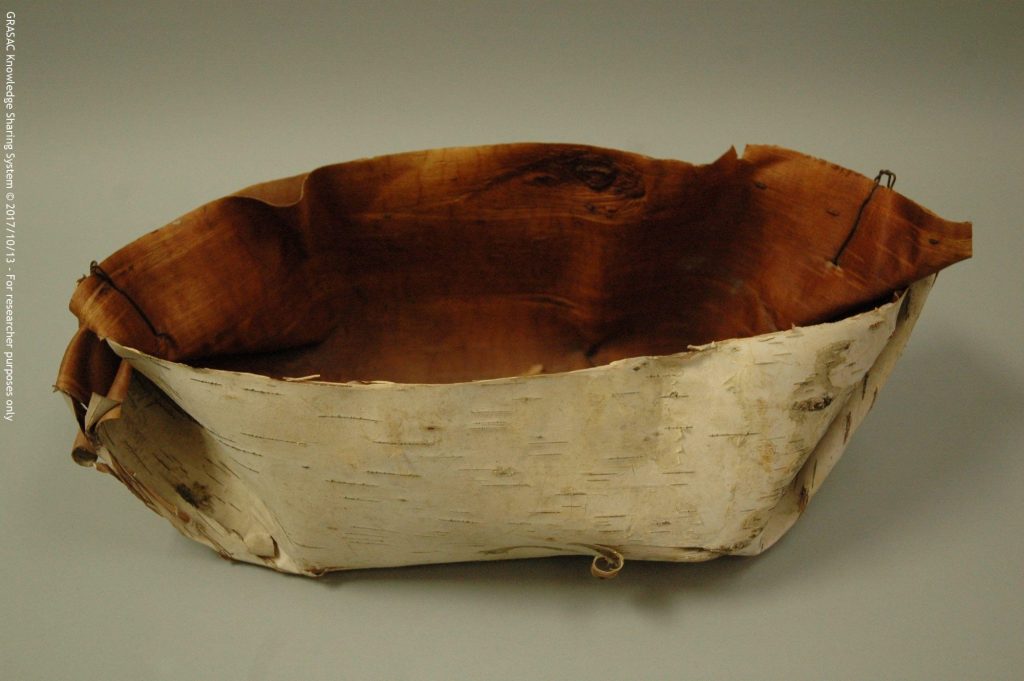
Many times the Anishinaabeg have been portrayed as people who did not know the value of their lands or of money. Sometimes this was true, other times the Anishinaabeg had a clear idea of the value of money and the resources tied to it. During the treaty negotiations for the 1862 Manitoulin Treaty, Ojibwe Chief Jako Atagewinini of Wikwemikong, stood up and stated his position to MacDougall regarding the cession of the island as well as the effect of past treaties.
My Brother I am happy to see you today in daylight. This is what I have always wanted. I said to myself: “Would that I may see the one who is in charge, so that I understand him and he understands me.” Listen my brother to what my chiefs say through me: Is it really now, when good fortune is beginning for the native, is it now that you have come to ask him for all his land! Be careful! Those natives who ceded the mainland [referring to Robinson Huron Treaty 1850] have not yet received any of the money that you promised to pay them. You promised them four piastres; now, see this (pants); they cost me four piastres, but I did not get them with what you gave for my land. It is the sugar that I take from the trees on my little island that gave them to me [emphasis added]. Look at me, brother, I am a chief from the mainland that my father ceded to the Great Woman Chief. If my father had come here, he would have spoken. I am not ashamed to reveal my misery to you. One thing amazes me. It is that the Great Woman-Chief comes to ask us for our property! Is she so poor? Does she not have abundant treasures over there in the land they call England? But we who have abandoned our property, we are unfortunate! Brother, understand my thoughts and those of my chiefs: we do not surrender any of our land.
[Father Choné to Scholastics, November 12, 1862, Letters from Manitoulin Island: 1853 – 1870. Compiled by Lorenzo Cadieux, s.j., and Robert Toupin, s.j., translated by Shelley Pearen and William Lonc, s.j.]
At a treaty negotiation on Manitoulin Island in 1862, Jako Atagewinini of the caribou clan explained that he was yet to receive his Robinson Huron annuities at the rate that he had expected but that amount was lacking. He said that he bought his pants, not with the annuity, but with the sugar that he had taken from the trees. Again, maple sugar is used as an example for revenue generation and is tied to independence, however, unlike the Prophet’s decree of selling excess production to whomever, Jako seemed to imply that he should be able to derive an adequate revenue from the produce of his land. Here maple sugar and access to resources is used in a political situation – a treaty negotiation.
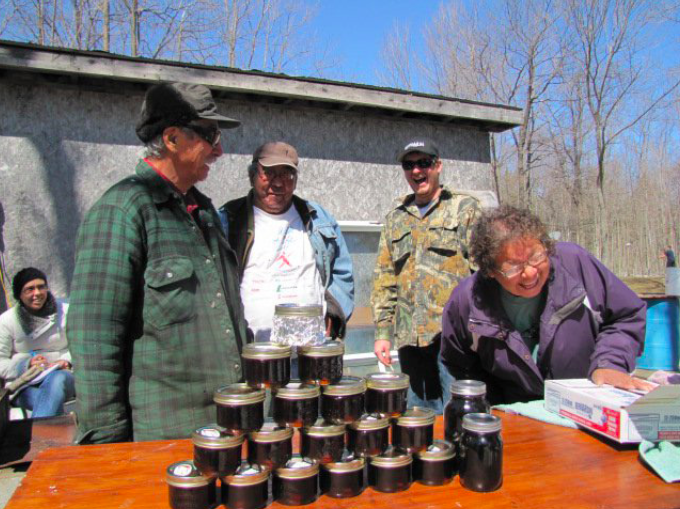
In the past, whenever the Anishinaabeg would visit the Fort at Michilimackinac or Fort St. Joseph, or the garrison on Drummond Island after the war of 1812, they would bring gifts of maple sugar in the spring and gifts of corn in the fall. Maple sugar in this case was used in a gift exchange in a political situation. The following provides vivid description of the political intercourse, it was recorded that on 3rd May 1796, that “Ogaw the Pickerel a principal Chief and four other Chiefs with a woman arrived from La Cloche they brought five makaks of sugar and received presents for the same.”
Later that same year, on 26th September 1796, “Five Canoes arrived and Three Chiefs (^ 71 in number) Ogaw – Miscoopenissy (^29 in number) of LaCloche & Minokeeshig (^35 in number). Ogaw presented nine bags of corn – he spoke for himself and the others expressing his and their good intentions towards the English and was glad of their being on his Land, hoped their father would protect them and shew them Charity, he spoke for Miscoopenissy on Sixteen Strings of Wampum.”
This Chief Ogaw ‘Pickerel’ was from Manitoulin Island and claimed premiere ownership of St. Joseph Island. After delivering the makaks and the bags of corn, the chief would then speak on strings of wampum. These were Ojibwe chiefs and people from LaCloche and Manitoulin. However, other Ojibwe chiefs from other areas also did the same. It was recorded that on “9 May 1797 – Watapineesh and family (^Chippewa) arrived from the Piniere and presented eight Makaks of sugar.” Then again on “10 May 1797 – Watapineesh received presents for himself & band consisting of fourteen – he was very well pleased and went away contented.” These are Ojibwe people, but the Odawa were not to be outdone; it was recorded that on 11 May 1797 that “Mitaminance & Nioukauté Ottawa Chiefs arrived from Arbre Croche they presented Twenty Makaks of sugar.” The following year, the secretary of the garrison noted that“Several Chiefs with their Bands from Arbre Croche arrived and presented Thirty Nine Makaks of sugar… Keeminichaugan spoke for all the Chiefs on a large Belt – “Father, I shew [sic] you this to let you know that we shall never part with it Sir John Johnson’s Father gave it to us at Niagara, saying, ‘Children This is my Belt, take it, let us always sit down on it and be of one mind, by doing so no bad Birds can hurt us.’” [references from Thomas Duggan Journal, Michilimackinack 1795 – 1801, Clements Library, University of Michigan, Ann Arbour].
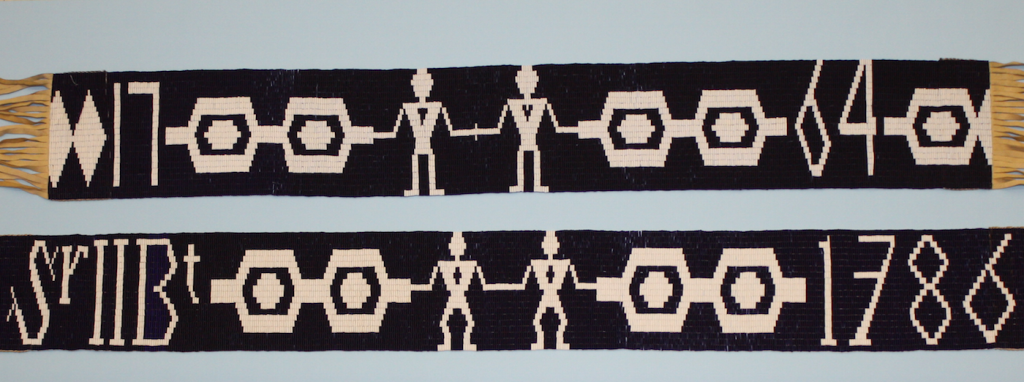
The Odawa chiefs then proceeded to lay out the wampum belts given to them by Sir William Johnson and Sir John Johnson (which were the covenant chain belts). Clearly the chiefs and colonial officials met in council and exchanged gifts as well as words. The gifts exchanged were practical for both sides, the garrison were provided with food supplements, and the Anishinaabeg with items of non-Native manufacture, such as cloth, kettles, and ammunition. This practice of giving corn and maple sugar to the garrison at British forts was prior to the Prophet’s injunctures in 1807.
However, after the War of 1812, this practice of giving corn and maple sugar to the garrison as gifts was continued. It was recorded in the Drummond Island book of Garrisons Orders that on June 21, 1817: “Arrived 831 Ottawa & Chippewa men women & children from L’Arbre Croche & Beaver Islands. Council No.5. Presented 45 mococks sugar and 8 [mats].” The garrison orders did not include the council proceedings. Further research revealed that “Council No. 5” was actually a delegation that included Chief Makatepinainse, who served as speaker, Chief Kashkinigua[k] [likely Giishkninj – Cut hand] , Chief Mocomanish & twenty three Ottawa Indians from L’Arbre Croche, with Jean Baptiste Assiginack serving as interpreter. Again the speaker, Makatepinesi was recorded as speaking with four strings of wampum [Library and Archives of Canada, RG 10, Vol. 34, p. 19988]. The council proceedings, which were a separate document, did not record that the delegation had brought a gift of “45 mococks of sugar and 8 mats.”
After the War of 1812, political relations between the Anishinaabeg and the British waned, as the Anishinaabeg were not viewed as necessary because peace was established with the Americans. However, maple sugar, maple sap and maple syrup continued to play a role in diplomacy, albeit, in internal diplomatic relations, and diplomatic relations with the clergy. In 187_, a Roman Catholic bishop visited Holy Cross Mission in Wikwemikong and it was noted that:
On Monday, his Lordship granted an audience to the chiefs and a number of the dignitaries of the village, with addresses and responses. At last the hour for the grand ceremony arrived. An immense concourse of people had gathered in front of our house; the belfy and the roofs of the neighboring dwellings were alive with eager spectators. Seats were disposed in the form of an amphitheatre, facing a temporary platform reserved for the orators of the occasion. According to custom, several large vessels were filled with sugared water, familiar to the Indians under the name of Okimawabo, ‘Water of the Chief’, so styled, because Indian etiquette requires that when the chief holds a convention he should be regaled with this beverage.”
[Paquin, p. 250].
In this passage Fr. Julien Paquin reported a ceremony held in honour of the bishop (he was being adopted and was to receive an Anishinaabe name). During this ceremony the assembled chiefs were also regaled with a beverage of sugared water, Ogimaawaaboo. This beverage has to have been sugared with maple sugar and not cane sugar, although Paquin does not state so explicitly. This maple sugar has been used to sweeten drinks for chiefs and their bands at community councils.
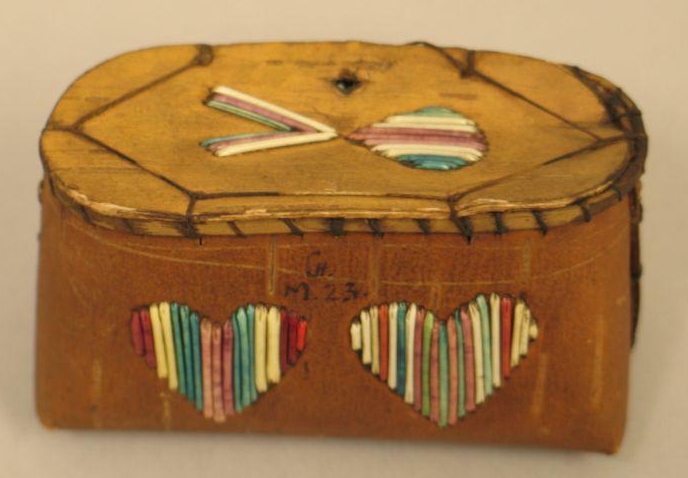
It is also likely that the maple sugar was used to sweeten drinks for more intimate get togethers. It is well known that the Anishinaabeg used to leave offerings at the graves of their loved ones. The little houses that were constructed over the grave had a hole in it to where one could place tobacco, tea and maple sugar. The early non-Native residents of Manitoulin noted this and thought it a waste and would often go and pillage the graves for the consumables. These items were left for the spirits of the dead as well as any visitors who could come and partake a smoke or a drink with the departed.
Many museums have these small quill decorated makaks in their collections, and they still have the maple sugar in them. One example was collected here on Manitoulin Island in 1845 and is now stored at the British museum. The collector, Henry Christy wrote on a label, “Maple Sugar 2 small birch box ___ made for childr__s at the graves of the [illegible –dead?].” So maple sugar was also left as an offering to the deceased.
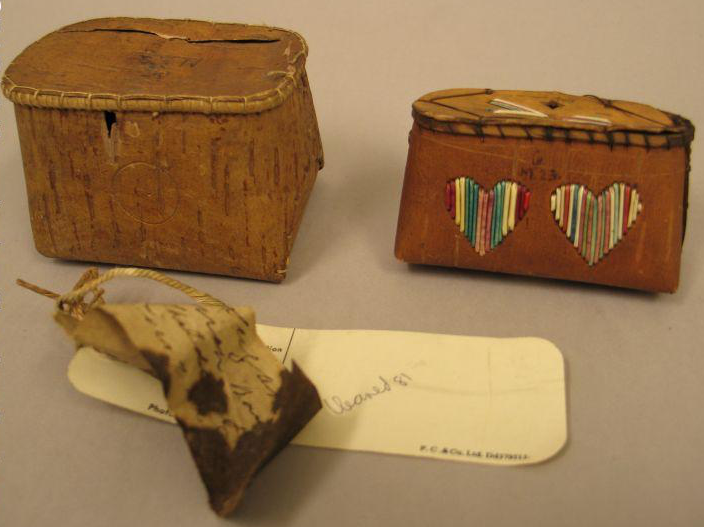
The maple tree ininaatig, has given its sap for the Anishinaabe to make syrup, taffy and sugar. These might be viewed merely as products in a market economy.
However, it is certain that the maple tree has, and continues to provide sustenance to the Anishinaabeg in multiple ways – physical nourishment for our bodies, nourishment for our spirits, economic livelihood for our needs, philosophical meaning for diplomacy, and cultural meaning in our religious ceremonies.
It must be that Nenaboozhoo has taught us well, for he said, “Now my nephews will have to labor hard to make the sugar out of this sap, and the sugar will be much more valuable to them in the future time.”
